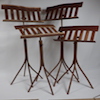I am going to be installing new garage doors in my shop. One of the criteria for the doors is that they have to have a rustic, board-and-batten look to them. They are flush, smooth wood doors with a plywood face. My plan is to glue and pin thin facing to each door so that it looks like B&B but is much thinner - I'm looking for basically 3/8" to 1/2" thick stock. I don't have a source for this locally so I will have to either make it myself or have it made. I do have a Delta 14" bandsaw with riser, so my idea is to use kiln-dried smooth boards and a coarse resaw blade, resaw the boards into thin pieces and glue and brad nail them onto the door face. My concern is being able to accurately resaw the boards (which will probably be random width from 1x6 to 1x10 and all at least 8' long) into thin stock, and still maintain a consistent thickness when done. Do you guys have any suggestions for accomplishing this? If I knew someone with an industrial resaw or bandsaw mill with resaw, I'd have them do it, but it looks like it's on me. Any suggestions as to a good blade choice and how to set up the cuts?
FWIW, these are going to be covered with a semi-transparent stain, so if there's any other ides floating around that will get me the same appearance without the amount of work I'm anticipating, I'm all for it. The shop itself will have eastern white pine board and batten siding, and I'm trying to match the look.




 Reply With Quote
Reply With Quote


